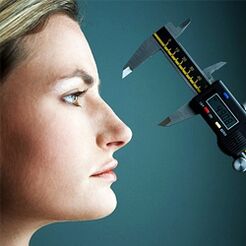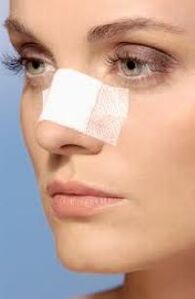The nose is the most visible part of the face, and its shape and general appearance determine a person’s perception by others. Many of us are not happy with our nose: some do not like its size or shape, others suffer from a hump or too wide wings, and still others want to fix the tip of a nose that cheerfully protrudes or, conversely, falls off. To the delight of patients, all these problems are simply solved with the help of one of the oldest plastic surgeries - rhinoplasty.
Rhinoplasty- surgery to correct (change) the shape or size of the nose, which aims to improve its appearance, as well as eliminate problems with nasal breathing and create a psychologically comfortable condition of the patient.
Types of rhinoplasty
Distinguish between aesthetic and reconstructive rhinoplasty.
The main goal of aesthetic rhinoplasty is to correct the "mistake" of nature by changing the shape or size of the nose, and thus give the face a more harmonious and attractive appearance. Aesthetic rhinoplasty can be either complete or superficial (partial).
Complete rhinoplasty is a plastic operation during which the surgeon touches all the structural parts of the so-called outer nose: bone tissue, cartilage tissue, as well as soft tissue. Such surgery is indicated for patients who want to reduce the length or width of the nose, change the shape of the saddle and remove the hump.
Partial (or superficial) rhinoplasty is an operation to correct (change) the shape of the nose, when the surgeon is limited to treating only some of the outer parts of the nose, without affecting the bone tissue. Partial rhinoplasty is performed if it is necessary to straighten the tip of the nose or reduce the wings, although complete rhinoplasty may be needed to eliminate such problems - this is decided by the doctor after examination and conversation with the patient.
Reconstructive rhinoplasty is primarily aimed at solving problems such as removing breathing difficulties due to curvature of the nasal septum or turbinate hypertrophy. Reconstructive rhinoplasty involves restoring the appearance of the nose, damaged (for example, "slipped to the side" due to a fracture), as well as partially or completely lost due to injury. This type of surgery is used if it is necessary to correct the congenital deformity of the osteochondral skeleton in the nasal region. Sometimes a plastic surgeon has to literally "sculpt" a new nose, using auricle cartilage or rib cartilage (in particularly severe cases) as well as artificial materials.
Often the patient has to undergo surgery not so much for cosmetic and aesthetic purposes, but to restore normal breathing, damaged due to deformation of the nasal septum received during trauma. Typically, post-traumatic surgery includes nasal plastic surgery and septoplasty (surgery aimed at correcting the nasal septum, whose main goal is to restore normal nasal breathing).
Preparation for rhinoplasty surgery

Before deciding on surgery, the patient together with the plastic surgeon discusses the future parameters and appearance of the nose, it turns out what exactly the patient wants to achieve, and the final result is simulated using a computer. This approach helps the patient "try out" a new nose on the face before surgery and ensure that his new look does not distort the overall proportions of the face, and the shape of the nose will blend harmoniously with all facial features.
It should also be borne in mind that rhinoplasty is not performed if the patient is under 17-18 years old. This is due to the growth of the body and the formation of cartilage and bone skeletons; the consequences of rhinoplasty at an earlier age can be unpredictable. But it is desirable to resort to rhinoplasty not earlier than 21 years - doctors say that by that time the bone skeleton is finally formed.
Characteristics of nose correction surgery
Rhinoplasty is recognized as one of the most difficult plastic surgeries: after all, it is important not only to change the nose and give it the desired size or shape, but also not to interfere with nasal breathing. Therefore, such an operation should be performed only by an experienced expert who has already proven himself and has good reviews from patients.
Rhinoplasty can be performed with both open and closed access. The open approach involves incising the skin from the outside, which will eventually be almost invisible. With a closed approach, the surgery is performed on the side of the nasal mucosa (through the nostrils) without any external incisions and leaves no traces. Closed rhinoplasty is considered more difficult and requires special skills of a plastic surgeon.
The type of approach is determined directly at the consultation and depends on many factors: the shape of the nose, the characteristics of its structure and the desired end result. The operation to correct the size or shape of the nose is performed under local anesthesia or under general anesthesia: the choice of anesthesia is influenced by the complexity of the surgical intervention and the duration of the proposed operation. . . . In any case, the patient is completely relieved of pain and does not feel discomfort.
Postoperative period

Rhinoplasty is a serious surgical intervention that requires not only a professional approach of the doctor, but also the responsibility of the patient during the rehabilitation period. The postoperative period is painless. Only for the first few days, tampons, which make nasal breathing difficult, bring some discomfort to the patient.
A plaster bandage is placed on the nose to tighten it, which is removed from time to time for skin care, in general, wearing such a bandage is mandatory for 7 to 10 days. At this time, the primary edema usually disappears and the bruising and swelling under the eyes disappear. The remaining subcutaneous induration, almost invisible to others, completely disappears in a period of 6-8 months. After this time, the final result of the rhinoplasty will be visible.
The patient is usually discharged the day after the operation, but still remains under the supervision of a doctor who comes to the clinic for examinations and dressings. The process of general recovery after rhinoplasty surgery lasts about a month, during which the patient is prescribed to wear a special bandage in the area of the nose, as well as to limit physical activity and eliminate bad habits (smoking, drinking alcohol).
A patient who has undergone rhinoplasty must undergo mandatory examinations by a plastic surgeon 3, 6 and 12 months after the operation.
Contraindications for rhinoplasty
An experienced plastic surgeon will refuse to perform the operation if the patient has a history of the following diseases:
- diseases of the cardiovascular system;
- blood clotting disorders;
- chronic liver and kidney diseases in the acute phase;
- oncological diseases;
- infectious diseases;
- mental illness.
Of course, rhinoplasty is a serious step in the life of a person who dreams of changing his nose, and at the same time his life. But many of us understand perfectly well: if any - even significant - figure flaws can be "concealed" or even turned into advantages with the help of clothing, then the ugly nose is the first thing others pay attention to when looking at a man's face. If the nose is too big or bumpy, such a "spectacle" can never be hidden, it will always spoil the look and mood. you look in the mirror.




















